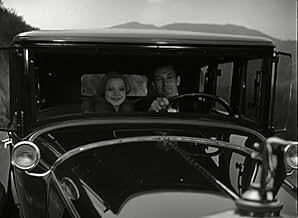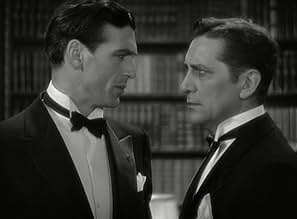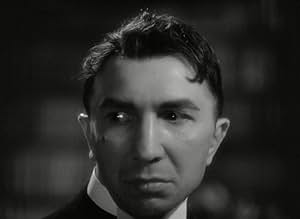- Premios
- 4 premios ganados en total
William 'Stage' Boyd
- McCoy
- (as William Boyd)
Terry Carroll
- Prison Inmate
- (sin créditos)
Allan Cavan
- Cop
- (sin créditos)
Bill Elliott
- Nightclub Patron
- (sin créditos)
Norman Foster
- Shooting Gallery Patron
- (sin créditos)
Paulette Goddard
- Nightclub Patron
- (sin créditos)
Bert Hanlon
- Baldy
- (sin créditos)
A.R. Haysel
- Fourth Henchman
- (sin créditos)
Matty Kemp
- Man Stabbed with Fork
- (sin créditos)
- Dirección
- Guionistas
- Todo el elenco y el equipo
- Producción, taquilla y más en IMDbPro
Opiniones destacadas
Clearly patterned after the first gangster movies that Warner produced the same year,Little Caesar (1931) and The Public Enemy (1931),this gangster movie is one of the better efforts I've seen. Although not quite in the same league as the previous mentioned classics, it has a powerful performance by young Sylvia Sidney.She's magnificent and delivers her lines more natural than perhaps anyone did at the time.Gary Cooper is better than usual at this stage in his career and shows signs of what would follow the next few years when he rose to the top. The movie has some fascinating villains in Paul Lukas (never seen him this detestable) and Guy Kibbee (what a shock to see him act the hoodlum).The direction of Rouben Mamoulian is very inventive,probably the first voice-over to show a persons thoughts appear in this movie. If you get the chance to see this little gangster flick, don't let the chance go by.
I saw this film last night at a "pre-Code" film festival, and I have to tell you that when Gary Cooper turned his head for his introductory close-up, the entire audience gasped. He was just that beautiful.
Cooper's looks aside, this film displays Rouben Mamoulian's directorial artistry to perfection. Wonderful scene-fades, creative camera angles, symbolic allusions--Mamoulian just keeps exploring the directorial medium and coming up with innovation.
This was Sylvia Sidney's first role in Hollywood, after her success on the New York stage, and she is just as lovely as a Gary Cooper leading lady ought to be. It's nice to see her in a role with a harder edge than many she was given--so often she looks like she's afraid she's about to be hit by someone.
There are lots of familiar faces in this film, including the wonderful Wynne Gibson. Most striking is Guy Kibbee, best known for playing fatuous rich men, as a grinning and mendacious hit-man.
There aren't nearly enough of these pre-Code films available on VHS or DVD, so if you can't find a pre-Code festival near you, try campaigning Turner Classic Movies for a broadcast! As for the reviewer who believes Gary Cooper was too stupid to have dialogue more complex than "Yep" or "Nope," he should perhaps consider Coop's performance in films such as "Mr Deeds Goes to Town" or "Meet John Doe." Although heaven knows anyone who looked that good shouldn't have to be smart as well.
Cooper's looks aside, this film displays Rouben Mamoulian's directorial artistry to perfection. Wonderful scene-fades, creative camera angles, symbolic allusions--Mamoulian just keeps exploring the directorial medium and coming up with innovation.
This was Sylvia Sidney's first role in Hollywood, after her success on the New York stage, and she is just as lovely as a Gary Cooper leading lady ought to be. It's nice to see her in a role with a harder edge than many she was given--so often she looks like she's afraid she's about to be hit by someone.
There are lots of familiar faces in this film, including the wonderful Wynne Gibson. Most striking is Guy Kibbee, best known for playing fatuous rich men, as a grinning and mendacious hit-man.
There aren't nearly enough of these pre-Code films available on VHS or DVD, so if you can't find a pre-Code festival near you, try campaigning Turner Classic Movies for a broadcast! As for the reviewer who believes Gary Cooper was too stupid to have dialogue more complex than "Yep" or "Nope," he should perhaps consider Coop's performance in films such as "Mr Deeds Goes to Town" or "Meet John Doe." Although heaven knows anyone who looked that good shouldn't have to be smart as well.
This is an odd film for several reasons. For one it is a gangster film made at Paramount, home of the sophisticated continental comedies and dramas. Also, you have Gary Cooper in a modern dress role but with that Montana twang on full display.
Gary Cooper plays "The Kid", a sharp shooter at a circus. His best girl is Nan Cooley (Sylvia Sydney). I can't say why they are going together, because Nan seems to dislike all of "The Kid's" outlooks and plans for the future. Nan's dad is a gangster played by an oddly cast Guy Kibbee (Pop), who is usually associated with being the comic relief over at Warner Brothers.
Nan helps "Pop" out whenever he wants to get rid of a getaway car or dispose of a weapon, but then one night her ruse doesn't work and she winds up being sent up the river for possession of a gun used in a murder done by dear old dad. And apparently "pop" only makes weak attempts to get her out of jail, although while she is inside he does use the opportunity to recruit the kid into the beer racket because of his handiness with a weapon.
Nan gets out and for some reason now sees The Kid as irresistible - a real about face in her attitude with no reason given. However she is very upset that dear old dad has her beau in with the rackets. Oh, and "The Big Fellow" (Paul Lukas), apparent head of the rackets, wants to throw over his current long time girlfriend and replace her with Nan, regardless of what Nan and the Kid think about it. Complications ensue.
The story is really conventional gangster lore - nothing to write home about. What makes it interesting is Mamoulian's direction and shots. He likes to linger on faces or even a stuffed bird. He's not really an "action packed" kind of director. There is great atmosphere with the prohibition era night spots taken over by the rowdy gangsters and shadows on the dark streets.
What makes it fun are some of the inconsistencies. The urban shots are done so that you feel like you are in a big city of the Northeast US. People in coats, talk of the cold, etc. But then the final chase scene comes and you see palm trees, canyons - it is obvious you are in southern California. And what is Cooper's character's real name? Everybody just calls him "Kid". That is who he is billed as.
I'd say watch it and just have fun with it. It certainly is different from a Warner Brothers gangster picture of the same era.
Gary Cooper plays "The Kid", a sharp shooter at a circus. His best girl is Nan Cooley (Sylvia Sydney). I can't say why they are going together, because Nan seems to dislike all of "The Kid's" outlooks and plans for the future. Nan's dad is a gangster played by an oddly cast Guy Kibbee (Pop), who is usually associated with being the comic relief over at Warner Brothers.
Nan helps "Pop" out whenever he wants to get rid of a getaway car or dispose of a weapon, but then one night her ruse doesn't work and she winds up being sent up the river for possession of a gun used in a murder done by dear old dad. And apparently "pop" only makes weak attempts to get her out of jail, although while she is inside he does use the opportunity to recruit the kid into the beer racket because of his handiness with a weapon.
Nan gets out and for some reason now sees The Kid as irresistible - a real about face in her attitude with no reason given. However she is very upset that dear old dad has her beau in with the rackets. Oh, and "The Big Fellow" (Paul Lukas), apparent head of the rackets, wants to throw over his current long time girlfriend and replace her with Nan, regardless of what Nan and the Kid think about it. Complications ensue.
The story is really conventional gangster lore - nothing to write home about. What makes it interesting is Mamoulian's direction and shots. He likes to linger on faces or even a stuffed bird. He's not really an "action packed" kind of director. There is great atmosphere with the prohibition era night spots taken over by the rowdy gangsters and shadows on the dark streets.
What makes it fun are some of the inconsistencies. The urban shots are done so that you feel like you are in a big city of the Northeast US. People in coats, talk of the cold, etc. But then the final chase scene comes and you see palm trees, canyons - it is obvious you are in southern California. And what is Cooper's character's real name? Everybody just calls him "Kid". That is who he is billed as.
I'd say watch it and just have fun with it. It certainly is different from a Warner Brothers gangster picture of the same era.
I've only seen a couple of Sylvia Sidney's early films, but they all seem to feature at least one closeup of her face that reveals what's really going on in the picture. In Hitchcock's "Sabotage," there's a fascinating shot of her working at a theater box office when a guy she likes suddenly shows up unannounced. Hitchcock went in tight on her face as it slowly changes from a blank expression to a glow of sheer joy. I've never seen anything like it in any other film. And here, in "City Streets," the director dollies in and lingers on her face for a full minute while Hollywood cinema's first "voiceover" tells us what's going on in her thoughts. But really, the words are superfluous, because her brown, luminous eyes tell us everything. Sidney was perhaps too exotic and unconventional to compete for major stardom with the Clara Bow flappers and Jean Harlow blonds of her time. She was also difficult to get along with, according to some sources. But she is more timeless than most. Dashiell Hammett, who wrote "City Streets," said she was the best part of the movie. For me, she's the best part of any movie she's in.
I thought I'd witnessed every wrinkle the crime/gangster flick had to offer, but the Garrett-Marcin-Hammett combination pull off some genuine thrills and surprises here, thanks to the inventively forceful direction by Mamoulian, the atmospheric photography by Lee Garmes, plus remarkably sharp film editing and flawless special effects. Brilliant acting helps too. Coop gives one of his most convincing performances as the reticent hayseed-turned-fearless bootlegger (the sort of character progression he was to repeat in other roles such as Sergeant York). Miss Sidney (pictured center) in her first major role is also an eye-opener. The principals receive great support from Paul Lukas, Wynne Gibson and Stanley Fields as the heavies, and even from Robert Homans' hard-as-nails detective. The movie has obviously been realized on an extensive budget which is brilliantly deployed in its realistic, crowd-filled sets.
¿Sabías que…?
- TriviaThis was Clara Bow's last film on her five-year contract, but due to her nervous breakdown, Sylvia Sidney replaced her after Nancy Carroll declined the part.
- ErroresWhen the henchman is talking to the out-of-town hit men, he gives Pop's address as beginning with a "6" before the scene cuts away. In the next scene, the address of the building is "165".
- ConexionesFeatured in Hollywoodism: Jews, Movies and the American Dream (1998)
Selecciones populares
Inicia sesión para calificar y agrega a la lista de videos para obtener recomendaciones personalizadas
- How long is City Streets?Con tecnología de Alexa
Detalles
- Fecha de lanzamiento
- País de origen
- Idioma
- También se conoce como
- After School
- Locaciones de filmación
- Productora
- Ver más créditos de la compañía en IMDbPro
- Tiempo de ejecución1 hora 23 minutos
- Color
Contribuir a esta página
Sugiere una edición o agrega el contenido que falta

Principales brechas de datos
By what name was City Streets (1931) officially released in Canada in English?
Responda


































